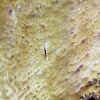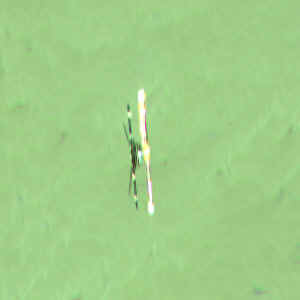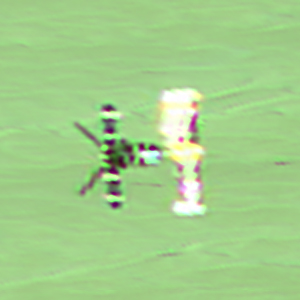For the first time ever in the history of
space observation: The Centre National d'Etudes Spatiales, CNES (French
Space Agency) took a spectacular picture of the European ERS-1 satellite via SPOT 4, the
most recent optical observation satellite in the SPOT family, which was launched on 24
March 1998.
 The viewing conditions were calculated at CNES and required
complete knowledge of the satellites' respective positions. SPOT 4's orbit was determined
using the facilities at the operations control centre for SPOT
satellites at CNES/Toulouse, while the orbit for ERS-1 was determined by the
ESA/ESOC/Darmstadt centre which controls it. The SPOT 4 telescopes, with their oblique
viewing mirror, took this image above the Ténéré desert in Niger, on 6 May 1998 at 9:56
UT.
The viewing conditions were calculated at CNES and required
complete knowledge of the satellites' respective positions. SPOT 4's orbit was determined
using the facilities at the operations control centre for SPOT
satellites at CNES/Toulouse, while the orbit for ERS-1 was determined by the
ESA/ESOC/Darmstadt centre which controls it. The SPOT 4 telescopes, with their oblique
viewing mirror, took this image above the Ténéré desert in Niger, on 6 May 1998 at 9:56
UT.
click to zoom in (859 KO)
From its orbit at an altitude of 820 km, SPOT 4 is able to
pick out details of 10 metres on the Earth's surface, which is moving at a speed of 24,000
km per hour. The ERS-1 orbit is 41 km below that of SPOT, which means that the latter can
distinguish details of 50 cm in size on ERS-1. However, since ERS-1 flies much lower it
flies faster than SPOT 4 and overtakes it with a relative velocity of about 250 km/h.
These exceptional viewing conditions explain why the raw image (18 columns by 125 rows) is
so distorted. Corrective processing was applied at CNES to
restore the normal appearance of ERS-1.
ERS-1 is a radar observation satellite. On the right-hand side of the image may be seen
the platform and the solar array, which are the same as SPOT's. On the left-hand side is
the long, rectangular, synthetic aperture radar antenna of 10m x 1m, as well as two of the
three scatterometer antennae used to measure wind fields. These two small antennae,
inclined at 45°, are shorter and narrower (with dimensions of 3.6 m x 0.25m) than that of
the radar, but stand out quite clearly in the image. The very bright areas in the image
are due to the sun's rays bounced off the highly reflective outer layer which protects the
satellite.
 |
 |
| Raw image -
© CNES |
Corrected
image - © CNES |
top of page, article

page updated on 2000-06-07
 The viewing conditions were calculated at CNES and required
complete knowledge of the satellites' respective positions. SPOT 4's orbit was determined
using the facilities at the operations control centre for SPOT
satellites at CNES/Toulouse, while the orbit for ERS-1 was determined by the
ESA/ESOC/Darmstadt centre which controls it. The SPOT 4 telescopes, with their oblique
viewing mirror, took this image above the Ténéré desert in Niger, on 6 May 1998 at 9:56
UT.
The viewing conditions were calculated at CNES and required
complete knowledge of the satellites' respective positions. SPOT 4's orbit was determined
using the facilities at the operations control centre for SPOT
satellites at CNES/Toulouse, while the orbit for ERS-1 was determined by the
ESA/ESOC/Darmstadt centre which controls it. The SPOT 4 telescopes, with their oblique
viewing mirror, took this image above the Ténéré desert in Niger, on 6 May 1998 at 9:56
UT. 
